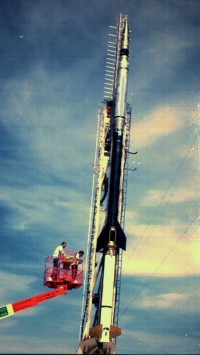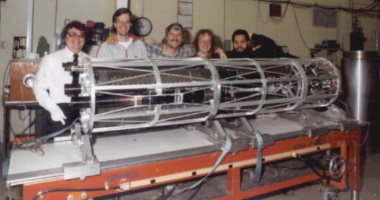
MSSTA
Encyclopedia

Sounding rocket
A sounding rocket, sometimes called a research rocket, is an instrument-carrying rocket designed to take measurements and perform scientific experiments during its sub-orbital flight. The origin of the term comes from nautical vocabulary, where to sound is to throw a weighted line from a ship into...
payload built by Professor A.B.C. Walker, Jr. at Stanford University
Stanford University
The Leland Stanford Junior University, commonly referred to as Stanford University or Stanford, is a private research university on an campus located near Palo Alto, California. It is situated in the northwestern Santa Clara Valley on the San Francisco Peninsula, approximately northwest of San...
in the 1990s to test EUV/XUV
Ultraviolet
Ultraviolet light is electromagnetic radiation with a wavelength shorter than that of visible light, but longer than X-rays, in the range 10 nm to 400 nm, and energies from 3 eV to 124 eV...
imaging of the Sun using normal incidence EUV-reflective multilayer optics . MSSTA contained a large number of individual telescopes (> 10), all trained on the Sun and all sensitive to slightly different wavelength
Wavelength
In physics, the wavelength of a sinusoidal wave is the spatial period of the wave—the distance over which the wave's shape repeats.It is usually determined by considering the distance between consecutive corresponding points of the same phase, such as crests, troughs, or zero crossings, and is a...
s of ultraviolet light. Like all sounding rockets, MSSTA flew for approximately 14 minutes per mission, about 5 minutes of which were in space—just enough time to test a new technology or yield "first results" science. MSSTA is one of the last solar observing instruments to use photographic film
Photographic film
Photographic film is a sheet of plastic coated with an emulsion containing light-sensitive silver halide salts with variable crystal sizes that determine the sensitivity, contrast and resolution of the film...
rather than a digital camera
Digital camera
A digital camera is a camera that takes video or still photographs, or both, digitally by recording images via an electronic image sensor. It is the main device used in the field of digital photography...
system such as a CCD
Charge-coupled device
A charge-coupled device is a device for the movement of electrical charge, usually from within the device to an area where the charge can be manipulated, for example conversion into a digital value. This is achieved by "shifting" the signals between stages within the device one at a time...
. MSSTA used film instead of a CCD in order to achieve the highest possible spatial resolution and to avoid the electronics difficulty presented by the large number of detectors that would have been required for its many telescopes.
MSSTA and its sister rocket, NIXT
NIXT
The NIXT, or Normal Incidence X-ray Telescope, was a sounding rocket payload flown in the 1990s by Professor Leon Golub of the Smithsonian Astrophysical Observatory, to prototype normal-incidence optical designs in extreme ultraviolet solar imaging...
, were prototypes for normal incidence EUV imaging telescopes that are in use today, such as the EIT instrument
Extreme ultraviolet Imaging Telescope
The Extreme ultraviolet Imaging Telescope is an instrument on the SOHO spacecraft used to obtain high-resolution images of the solar corona in the ultraviolet range...
aboard the SOHO
Solar and Heliospheric Observatory
The Solar and Heliospheric Observatory is a spacecraft built by a European industrial consortium led by Matra Marconi Space that was launched on a Lockheed Martin Atlas IIAS launch vehicle on December 2, 1995 to study the Sun, and has discovered over 2100 comets. It began normal operations in May...
spacecraft, and the TRACE
TRACE
TRACE was a NASA space telescope designed to investigate the connections between fine-scale magnetic fields and the associated plasma structures on the Sun by providing high resolution images and observation of the solar photosphere and transition region to the corona...
spacecraft. MSSTA flew three times: once in 1991 (NASA Sounding Rocket flight 36.049), once in 1994 (flight 36.091), and once in 2002 (flight 36.194). While Dr. Walker's 1991 telescope was the first in the series to carry the MSSTA moniker, the precursor to the MSSTA, the Stanford/MSFC Rocket Spectroheliograph (NASA Sounding Rocket flight 27.092), which carried two EUV telescopes in 1987, was the first mission to successfully obtain high-resolution, full-disk solar images utilizing normal incidence EUV optics
. The MSSTA I flown in 1991 carried 14 telescopes; the MSSTA II flown in 1994 carried 19 telescopes; and the MSSTA III flown in 2002 carried 11 telescopes.
Several Stanford Ph.D. degrees in Physics resulted from the MSSTA program. These include those earned by Dr. Joakim Lindblom, Dr. Maxwell J. Allen, Dr. Ray H. O'Neal, Dr. Craig E. DeForest, Dr. Charles C. Kankelborg, Dr. Hakeem M. Oluseyi, Dr. Dennis S. Martinez-Galarce, and Dr. Paul F.X. Boerner.


